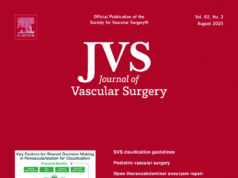
A new propensity-matched analysis of more than 1,100 lower extremity revascularization procedures carried out in patients with chronic limb-threatening ischemia (CLTI)—which aimed to help solve the puzzle of why the BEST-CLI trial did not lead to a pick-up in the rate of surgical bypass in the year after its publication—validated the landmark study’s results, according to the senior author.
The Beth Israel Deaconess Medical Center (BIDMC) retrospective review showed that, like in BEST-CLI cohort 1, the primary outcome measure of major adverse limb events (MALE) and MALE/death was noted to be significantly decreased following a bypass with single-segment great saphenous vein (GSV) as compared to percutaneous transluminal angioplasty with or without stenting at five years (51% vs. 60% and 75% vs. 79%, respectively). “These findings correlated with a 29% and 20% reduction in the aforementioned events,” first author Jeremy Darling, MD, reported as he delivered the findings during the 2025 Society for Clinical Vascular Surgery (SCVS) Annual Symposium in Austin, Texas (March 29–April 2). And, similar to BEST-CLI cohort 2, in which patients did not have a suitable GSV for conduit, significant differences in MALE and MALE/death were not noted.
The analysis grew out of a prior Vascular Quality Initiative (VQI) study conducted by Boston-based BIDMC researchers in which they discovered that there had been no increase in bypasses placed for CLTI 12 months on from BEST-CLI, despite the trial demonstrating that surgical bypass with adequate single-segment GSV is a more effective revascularization strategy in those who are deemed suitable for either an open or endovascular approach.
Darling and colleagues, led by Marc Schermerhorn, MD, BIDMC chief of vascular surgery and the analysis’ senior author, theorized that the lack of pick-up could have been influenced by specialists not believing that the BEST-CLI results were generalizable. “We were able to mimic cohorts 1 and 2 from the study, we matched all of the outcomes,” explained Schermerhorn in an interview with Vascular Specialist. “All of the proportions are fairly similar to BEST-CLI. We did have more dialysis patients than they had in BEST-CLI, but otherwise it was fairly similar.” The results, he said, validate the differences BEST-CLI demonstrated, with just one exception. “The only thing that they saw in BEST-CLI that we did not see in cohort 1 was the difference in amputation rates, where we had an amputation rate that was just as low in the angioplasty patients as in the bypass patients.”
The correlation “suggests generalizability” of BEST-CLI, Schermerhorn said. He hopes the results of the analysis stimulate more specialists to consider a bypass-first strategy when they are confronted with a patient who has extensive CLTI and a viable single-segment GSV. “I do think people should re-think their treatment protocol,” he argued. “They should routinely evaluate the saphenous vein before they go to the angiosuite, and that knowledge of whether there is a good single-segment saphenous vein available should have a significant impact on the choice to attempt an endovascular revascularization, as opposed to going right to bypass.”
In a similar vein, the research group have also tackled the results from BASIL-2 in an analysis due to be presented at this year’s Vascular Annual Meeting (VAM). “We re-structured the cohort and to tied to mimic the BASIL-2 trial,” Schermerhorn added. “That is also one of the reasons why people may not be changing their practice patterns based on the BEST-CLI trial, because there were somewhat conflicting results from BASIL-2.” The latter trial, which included 345 patients, showed that a best endovascular treatment-first revascularization strategy was associated with better amputation-free survival than a vein bypass-first strategy in those who required an infrapopliteal repair.












